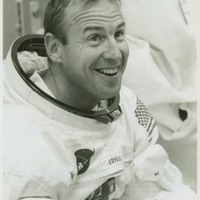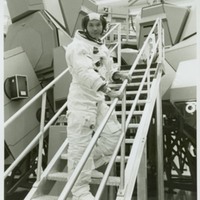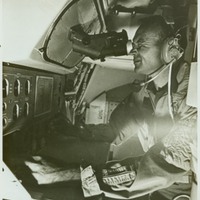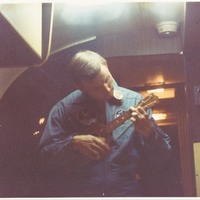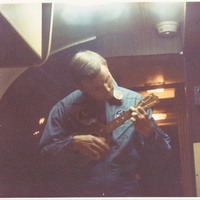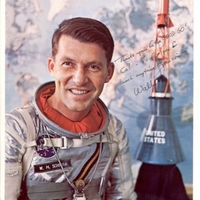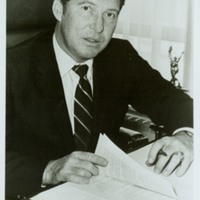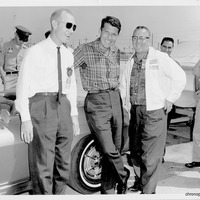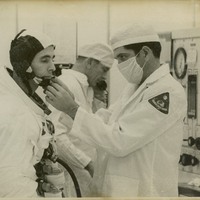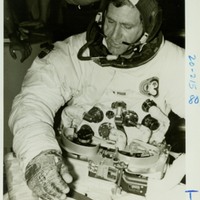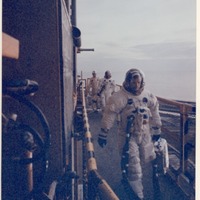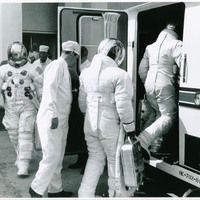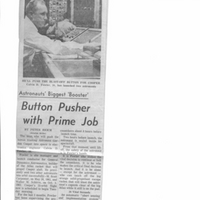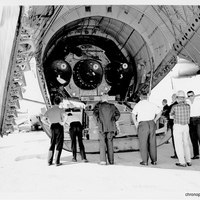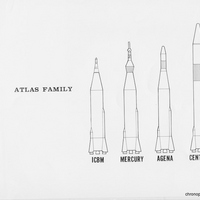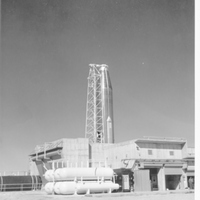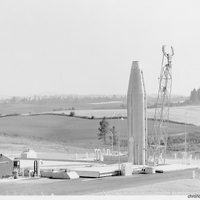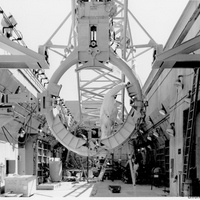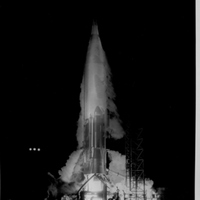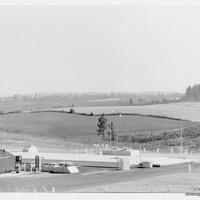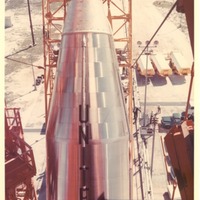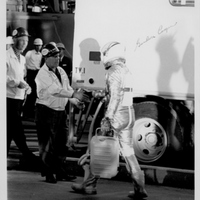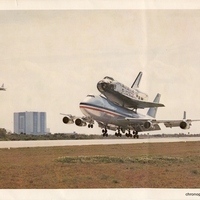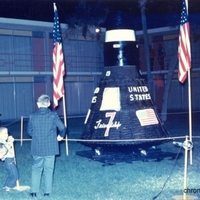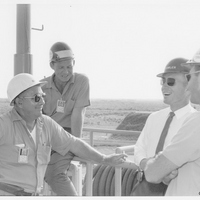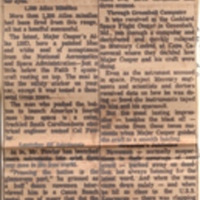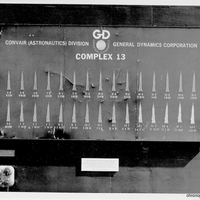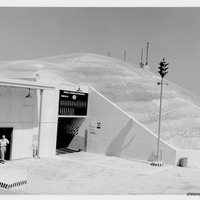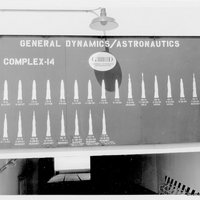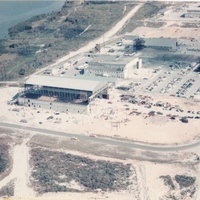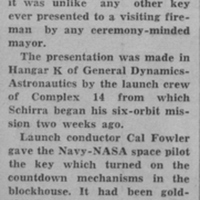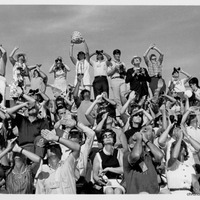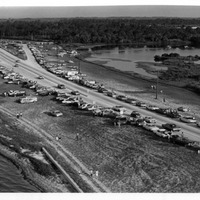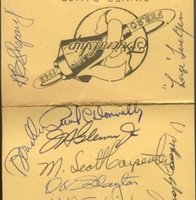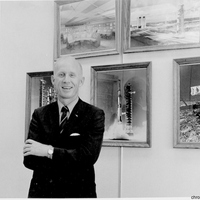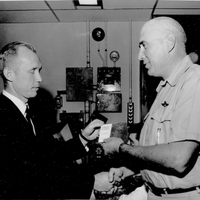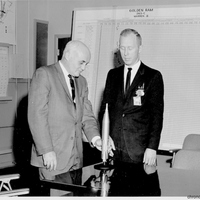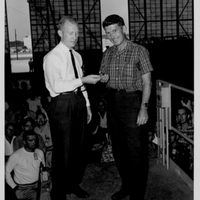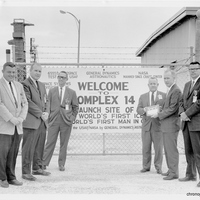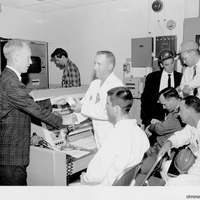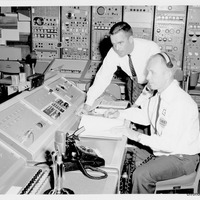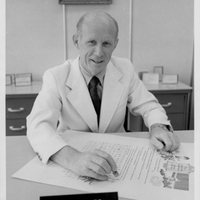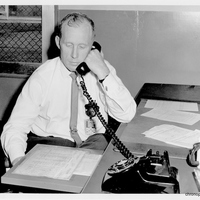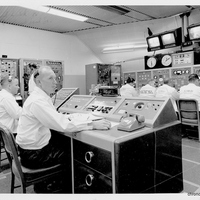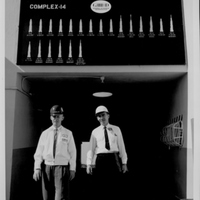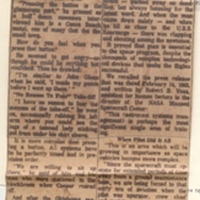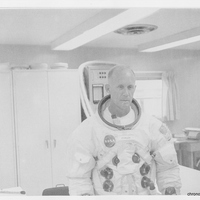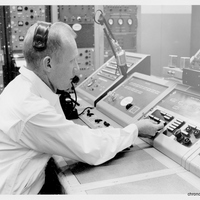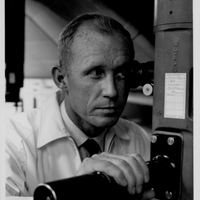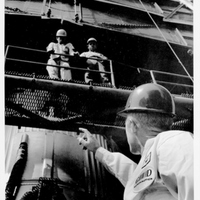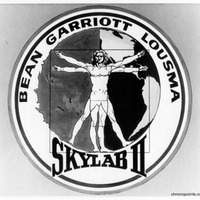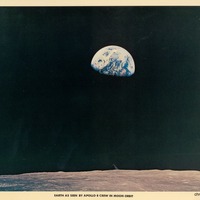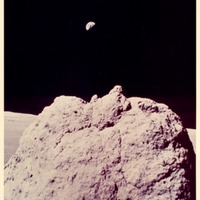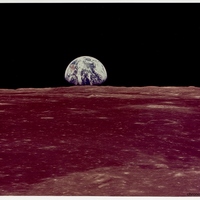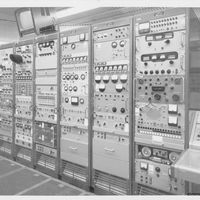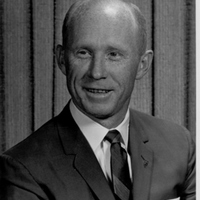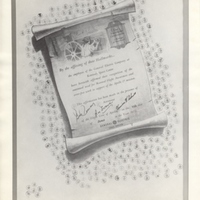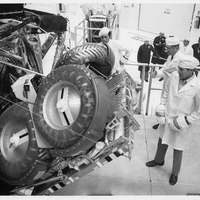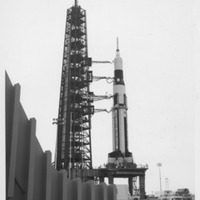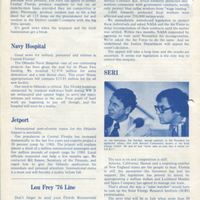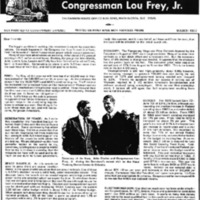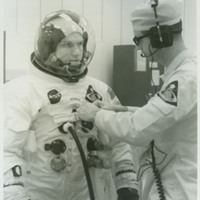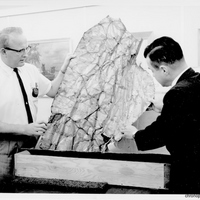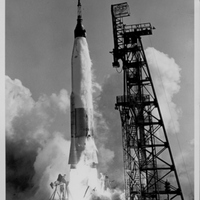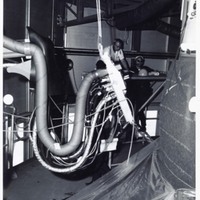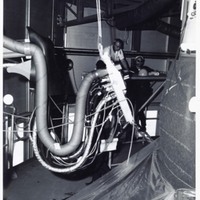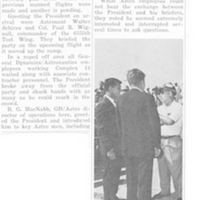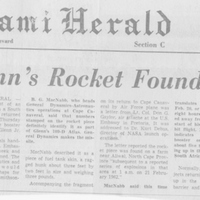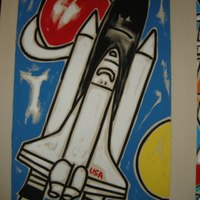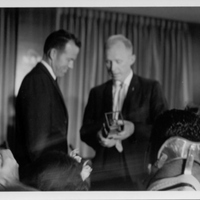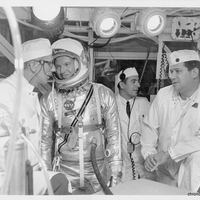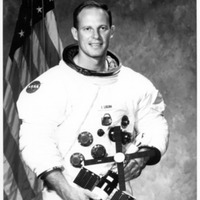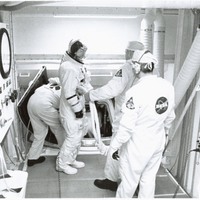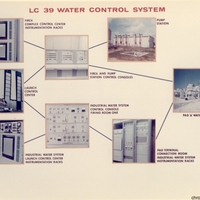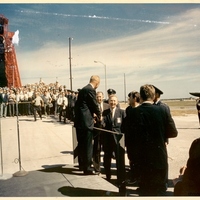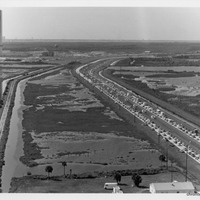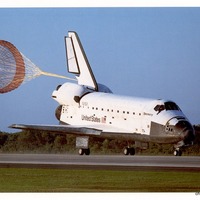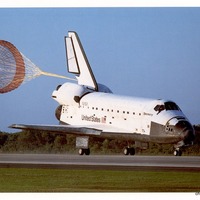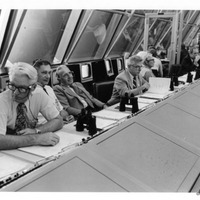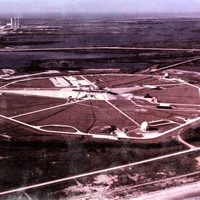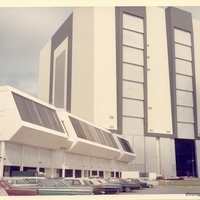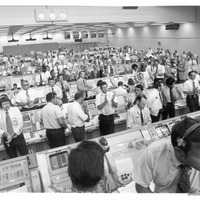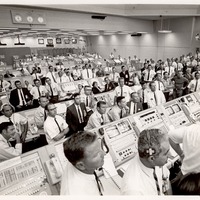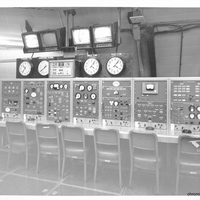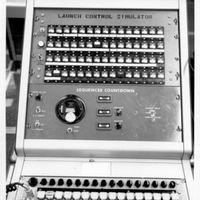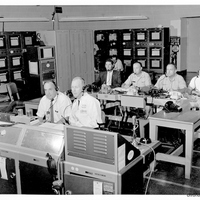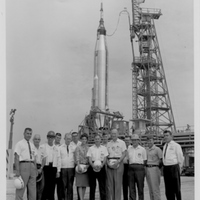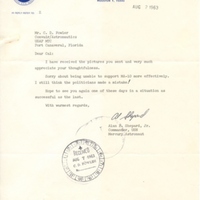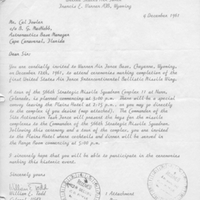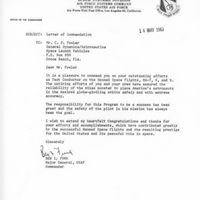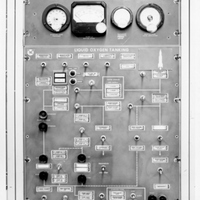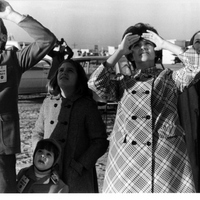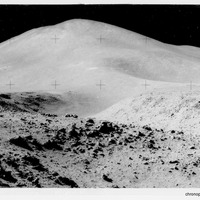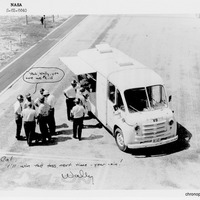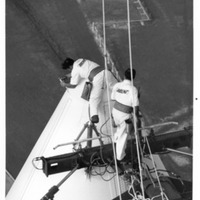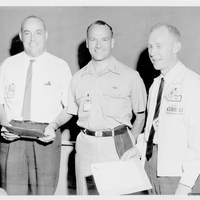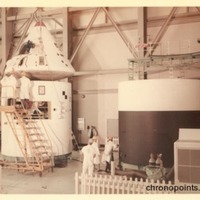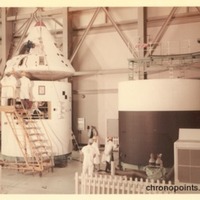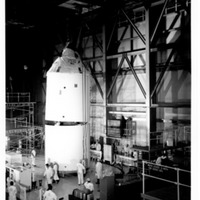Browse Items (298 total)
- Tags: National Aeronautics and Space Administration
Astronaut Jim Lovell During Suit Test for Apollo 8
Astronaut Michael Collins During Apollo 11 Training
Astronaut Michael Collins in the Command Module Procedures Simulator
Astronaut Neil Armstrong in Mobile Quarantine Facility
Astronaut Neil Armstrong in Mobile Quarantine Facility
Astronaut Wally Schirra
Tags: Astronaut Group 1; astronauts; Cal Fowler; Calvin D. Fowler; Cape Canaveral AFS; Cape Canaveral Air Force Station; Launch Complex 14; LC-14; MA-8; Mercury; Mercury 7; Mercury Seven; Mercury-Atlas; Mercury-Atlas 8; NASA; National Aeronautics and Space Administration; Original Seven; outer space; Project Mercury; Sigma 7; space exploration; space programs; Wally Schirra; Walter Marty Schirra, Jr.
Astronaut Wally Schirra
Astronaut Wally Schirra and B. G. MacNabb
Tags: astronauts; B. G. MacNabb; Cape Canaveral; Cape Canaveral AFS; Cape Canaveral Air Force Station; CCAFS; GDA; General Dynamics/Astronautics; Hangar S; Mercury; moat; moats; NASA; National Aeronautics and Space Administration; outer space; Project Mercury; Sigma 7; space exploration; space programs; Wally Schirra; Walter Marty Schirra, Jr.
Astronaut William Anders During Suit Test for Apollo 8
Astronaut William R. Pogue Training for Skylab 4
Astronauts Boarding Apollo 11
Tags: Apollo 11; Apollo Project; Buzz Aldrin; Edwin Eugene Aldrin, Jr.; John F. Kennedy Space Center; Kennedy Space Center; KSC; Launch Complex 39A; Launch Pad 39A; Launch Umbilical Tower; LC-39A; LUT; Merritt Island; Michael Collins; NASA; National Aeronautics and Space Administration; Neil Alden Armstrong; Neil Armstrong; Project Apollo; space
Astronauts Load into Transfer Van for Apollo 7 Launch Demonstration Test
Tags: Apollo 7; Apollo Project; astronauts; Cape Canaveral; Cape Canaveral Air Force Station; CCAFS; Donn F. Eisele; Donn Fulton Eisele; NASA; National Aeronautics and Space Administration; Project Apollo; Ronnie Walter Cunningham; space; Wally Schirra; Walt Cunningham; Walter Cunningham; Walter Marty Schirra, Jr.
Astronauts' Biggest 'Booster': Button Pusher with Prime Job
Tags: abort sensing and information system; ASIS; astronauts; Atlas; Atlas 130-D; Cal Fowler; Calvin D. Fowler; Cape Canaveral; Cape Canaveral AFS; Cape Canaveral Air Force Station; Cape Canaveral Air Force Station Launch Complex 14; Carpenter, Malcolm Scott; Carpenter, Scott; CCAFS; GDA; General Dynamics/Astronautics; Gordo Cooper; Gordon Cooper; launch; Launch Complex 14; launches; LC-14; Leroy Gordon Cooper, Jr.; Mercury; Mercury-Atlas; NASA; National Aeronautics and Space Administration; outer space; Peter Reich; Project Mercury; Reich, Peter; space exploration; space programs; spacecraft; Wally Schirra; Walter Marty Schirra, Jr.
Atlas Core Arriving at Cape Canaveral
Tags: Atlas; Cape Canaveral; Cape Canaveral AFS; Cape Canaveral Air Force Station; CCAFS; Convair; Convair/General Dynamics; General Dynamics; Launch Complex 14; LC-14; Mercury; missiles; NASA; National Aeronautics and Space Administration; outer space; Project Mercury; Skid Strip; space exploration; space programs
Atlas Family Chart
Atlas ICBM at Francis E. Warren Air Force Base
Atlas ICBM Fueling Test at Fairchild Air Force Base
Atlas ICBM Installation at Francis E. Warren Air Force Base
Tags: Atlas; Atlas E; Atlas F; Atlas ICBM; cable tunnel; Cal Fowler; Calvin D. Fowler; coffin site; Francis E. Warren Air Force Base; intercontinental ballistic missiles; Launch Operations Building; Launch Service Building; LOB; LSB; missiles; NASA; National Aeronautics and Space Administration; rockets; space; Warren AFB; Warren III
Atlas ICBM Test Launch
Atlas Intercontinental Ballistic Missile Fuel Loading Test at Fairchild Air Force Base
Tags: 31-E; AFB; Air Force Base; Atlas; Fairchild AFB; Fairchild Air Force Base; fueling tests; General Dynamics/Astronautics; ICBM; intercontinental ballistic missiles; launch sites; NASA; National Aeronautics and Space Administration; outer space; silos; space exploration; space programs; U.S. Air Force
Atlas Rocket Under Construction at the Cape Canaveral Air Force Station Launch Complex 14
Tags: Astronaut Group 1; Atlas 130D; Cape Canaveral; Cape Canaveral AFS; Cape Canaveral Air Force Station; CCAFS; Faith 7; Launch Complex 14; Launch Pad 14; LC-14; MA-9; Mercury 7; Mercury Seven; Mercury-Atlas; Mercury-Atlas 9; NASA; National Aeronautics and Space Administration; Original Seven; outer space; Project Mercury; space exploration; space programs
B. G. MacNabb with Astronaut Gordon Cooper
Tags: Astronaut Group 1; astronauts; B. G. MacNabb; Cape Canaveral; Cape Canaveral AFS; Cape Canaveral Air Force Station; CCAFS; Faith 7; GDA; General Dynamics/Astronautics; Gordo Cooper; Gordon Cooper; Launch Complex 14; Launch Pad 14; LC-14; Leroy Gordon Cooper, Jr.; MA-9; Mercury; Mercury 7; Mercury Seven; Mercury-Atlas; Mercury-Atlas 9; NASA; National Aeronautics and Space Administration; Original Seven; outer space; Project Mercury; space exploration; space programs
Boeing 747 Transporting the Space Shuttle Columbia
Tags: Boeing 747; John F. Kennedy Space Center; Kennedy Space Center; KSC; Mate/Demate Device; Merritt Island; NASA; National Aeronautics and Space Administration; OV-102; Shuttle Landing Facility; space; Space Shuttle Columbia; Space Shuttle Program; Space Shuttles; Space Transport; Space Transportation System; STS
Cake in Honor of John Herschel Glenn, Jr. and Friendship 7
Tags: Astronaut Group 1; cakes; Cal Fowler; Calvin D. Fowler; Cape Canaveral; Cape Canaveral Air Force Station; CCAFS; Friendship 7; Henri Landwirth; John Herschel Glenn, Jr.; Mercury 7; Mercury Seven; NASA; National Aeronautics and Space Administration; Original Seven; Project Mercury; space; spacecraft
Cal Fowler and Others at the Cape Canaveral Air Force Station Launch Complex 14
Tags: Cal Fowler; Calvin D. Fowler; Cape Canaveral; Cape Canaveral AFS; Cape Canaveral Air Force Station; CCAFS; GDA; General Dynamics/Astronautics; Launch Complex 14; Launch Complex Manager; LC-14; Mercury; Mercury-Atlas; NASA; National Aeronautics and Space Administration; outer space; Project Mercury; space exploration; space programs
Canaveral Leaves Mind Sharp Bits Amid Clutter
Tags: astronauts; Atlas; Atlas 130-D; Cal Fowler; Calvin D. Fowler; Cape Canaveral; Cape Canaveral Air Force Station; CCAFS; Cocoa Beach; Goddard Space Flight Center; Gordo Cooper; Greenbelt; Greenbelt, Maryland; John Herschel Glenn, Jr.; launch; Launch Complex 14; LC-14; Leroy Gordon Cooper, Jr.; LHD-3; MA-9; Manned Spacecraft Center; Mercury 7; Mercury Control; Mercury-Atlas; Mercury-Atlas 9; missiles; NASA; National Aeronautics and Space Administration; Project Mercury; Robert B. Voss; rockets; space; Stephen A. Bennett; USS Kearsarge
Cape Canaveral Air Force Station Launch Complex 13 Launch Tote Board
Tags: Atlas; blockhouses; Cape Canaveral; Cape Canaveral AFS; Cape Canaveral Air Force Station; CCAFS; Convair; Convair Astronautics Division; GDA; General Dynamics Corporation; General Dynamics/Astronautics; Launch Complex 13; Launch Complex 13 Blockhouse; launches; LC-13; NASA; National Aeronautics and Space Administration; outer space; space exploration; space programs; tote boards
Cape Canaveral Air Force Station Launch Complex 14 Blockhouse
Cape Canaveral Air Force Station Launch Complex 14 Blockhouse Launch Tote Board
Tags: blockhouses; Cape Canaveral; Cape Canaveral AFS; Cape Canaveral Air Force Station; Launch Complex 14; Launch Complex 14 Blockhouse; launch tote boards; LC-14; Mercury; Mercury-Atlas; NASA; National Aeronautics and Space Administration; outer space; Project Mercury; space exploration; space programs
Construction of Special Assembly Building
Countdown "Key" Given to Schirra by Convair Crew
Crowd Observes the Apollo 15 Launch
Crowds Observing the Apollo 11 Launch Along Florida State Road A1A
Tags: Apollo 11; Apollo Project; Bee Line; Florida State Road 528; Florida State Road A1A; John F. Kennedy Space Center; Kennedy Space Center; KSC; launch; Martin Andersen Beachline Expressway; Martin Andersen Bee Line Expressway; Merritt Island; NASA; National Aeronautics and Space Administration; Project Apollo; space; SR 528; SR A1A
Dinner Dance in Honor of John Herschel Glenn, Jr. and Friendship 7 Program
Tags: Al Shepard; Alan Bartlett Shepard, Jr.; Anna Margaret Castor Glenn; Annie Castor Glenn; Astronaut Group 1; B. G. McNabb; Cal Fowler; Calvin D. Fowler; Cocoa; Cocoa Armory; Deke Slayton; Donald Kent Slayton; Friendship 7; General Dynamics Astronautics; Gordo Cooper; John Herschel Glenn, Jr.; Leroy Gordon Cooper, Jr.; Luge Luetjen; MA-6; Malcolm Scott Carpenter; McDonnell Aircraft Corporation; Mercury 7; Mercury Seven; Mercury-Atlas; Mercury-Atlas 6; NASA; National Aeronautics and Space Administration; Original Seven; Paul Charles Donnelly; Project Mercury; space; spacecraft; T. J. O'Malley; Thomas Joseph O'Malley; Wally Schirra; Walter Marty Schirra, Jr.
Dr. Cal Fowler
Dr. Cal Fowler and Lieutenant Colonel Swazey
Dr. Cal Fowler Presenting the Atlas E Model to Eugene Martin Zuckert
Tags: Atlas; Atlas E; Atlas ICBM; Cal Fowler; Calvin D. Fowler; Eugene Martin Zuckert; Francis E. Warren Air Force Base; General Dynamics/Astronautics; intercontinental ballistic missiles; missiles; NASA; National Aeronautics and Space Administration; rockets; Secretary of the Air Force; space; U.S. Air Force; USAF; Warren AFB; Warren III
Dr. Cal Fowler Presenting Wally Schirra with Launch Key
Tags: Astronaut Group 1; astronauts; Atlas; Cal Fowler; Calvin D. Fowler; Cape Canaveral; Cape Canaveral Air Force Station; CCAFS; General Dynamics Astronautics; Hangar J; Launch Complex 14; LC-14; MA-8; Mercury 7; Mercury Seven; Mercury-Atlas; Mercury-Atlas 8; NASA; National Aeronautics and Space Administration; orbit; Original Seven; Project Mercury; Sigma 7; space; spacecraft; U.S. Air Force; USAF; Wally Schirra; Walter Marty Schirra, Jr.
Dr. Cal Fowler Receiving the Sapley Award
Tags: 6555th Aerospace Test Group; B. G. McNabb; Cal Fowler; Calvin D. Fowler; Cape Canaveral; Cape Canaveral Air Force Station; CCAFS; General Dynamics Astronautics; George Page; Jim Stakey; Launch Complex 14; LC-14; Manned Space Craft Center; NASA; National Aeronautics and Space Administration; Ned Mullins; Sapley Award; space; Space Systems division; U.S. Air Force; USAF
Dr. Cal Fowler Strategic Air Command
Dr. Cal Fowler, 1960
Dr. Calvin D. Fowler and Wayne Reid at Launch Conductor's Workstation in Cape Canaveral Air Force Station Launch Complex 14
Tags: Aerospace Corporation; blockhouses; Cal Fowler; Calvin D. Fowler; Cape Canaveral; Cape Canaveral AFS; Cape Canaveral Air Force Station; CCAFS; GDA; General Dynamics/Astronautics; Launch Complex 14; Launch Conductor; LC-14; NASA; National Aeronautics and Space Administration; outer space; space exploration; space programs; Wayne Reid
Dr. Calvin D. Fowler Applying His Engineering Hallmark
Tags: Apollo 17; Apollo Project; Fowler, Cal; Fowler, Calvin "Cal" D.; GE; General Electric Company; hallmark; hallmark of excellence; inspection; John F. Kennedy Space Center; Kennedy Space Center; KSC; Manned Flight Awareness; MFA; NASA; National Aeronautics and Space Administration; outer space; space; space exploration; space program
Dr. Calvin D. Fowler as a Test Conductor at Cape Canaveral Air Force Station Launch Complex 11
Dr. Calvin D. Fowler at the Cape Canaveral Air Force Station Launch Complex 14 Blockhouse's Launch Conductor Console
Tags: blockhouses; Cal Fowler; Calvin D. Fowler; Cape Canaveral; Cape Canaveral AFS; Cape Canaveral Air Force Station; Launch Complex 14; Launch Complex 14 Blockhouse; Launch Conductor; LC-14; Mercury; Mercury-Atlas; NASA; National Aeronautics and Space Administration; outer space; Project Mercury; space exploration; space programs
Dr. Calvin D. Fowler Exiting Cape Canaveral Air Force Station Launch Complex 14 Blockhouse
Tags: blockhouses; Cape Canaveral AFS; Cape Canaveral Air Force Station; Fowler, Cal; Fowler, Calvin "Cal" D.; GDA; General Dynamics/Astronautics; Launch Complex 14; Launch Complex 14 Blockhouse; launch tote board; LC-14; NASA; National Aeronautics and Space Administration; outer space; space exploration; space programs; tote boards
Dr. Calvin D. Fowler Interviewed After Astronaut Gordon Cooper's Spaceflight
Tags: airplanes; Astronaut Group 1; astronauts; Atlas 130D; Cal Fowler; Calvin D. Fowler; Cocoa Beach; Faith 7; Goddard Space Flight Center; Gordo Cooper; Gordon Cooper; John Glenn; John Herschel Glenn, Jr.; Kearsarge; Leroy Gordon Cooper, Jr.; MA-9; Manned Spacecraft Center; Mercury; Mercury 7; Mercury Control Center; Mercury Seven; Mercury-Atlas; Mercury-Atlas 9; NASA; National Aeronautics and Space Administration; Original Seven; outer space; planes; Project Mercury; Robert B. Voss; space exploration; space programs; spaceflight; USS Kearsarge; Wiley Hardeman Post; Wiley Post
Dr. Calvin D. Fowler Trying on a Space Suit at John F. Kennedy Space Center
Dr. Calvin D. Fowler Using Launch Console at the Cape Canaveral Air Force Station Launch Complex 14 Blockhouse
Tags: Aurora 7; blockhouses; Cal Fowler; Calvin D. Fowler; Cape Canaveral; GE; General Dynamics/Astronautics; Launch Complex 14; Launch Conductor; launch consoles; LC-14; MA-7; Malcolm Scott Carpenter; Mercury; Mercury-Atlas; Mercury-Atlas 7; NASA; National Aeronautics and Space Administration; outer space; Periscope; Project Mercury; Scott Carpenter; space exploration; space programs
Dr. Calvin D. Fowler Using Periscope at the Cape Canaveral Air Force Station Launch Complex 14 Blockhouse
Tags: Aurora 7; blockhouses; Cal Fowler; Calvin D. Fowler; Cape Canaveral; GE; General Dynamics/Astronautics; Launch Complex 14; Launch Conductor; LC-14; MA-7; Malcolm Scott Carpenter; Mercury; Mercury-Atlas; Mercury-Atlas 7; NASA; National Aeronautics and Space Administration; outer space; Periscope; Project Mercury; Scott Carpenter; space exploration; space programs
Dr. Calvin D. Fowler Visiting Launchpad at the Cape Canaveral Air Force Station Launch Complex 14 Blockhouse
Tags: Aurora 7; Cal Fowler; Calvin D. Fowler; Cape Canaveral; GE; General Dynamics/Astronautics; Launch Complex 14; Launch Conductor; launch sites; launchpads; LC-14; MA-7; Malcolm Scott Carpenter; Mercury; Mercury-Atlas; Mercury-Atlas 7; NASA; National Aeronautics and Space Administration; outer space; Periscope; Project Mercury; Scott Carpenter; space exploration; space programs
Early Version of Skylab 3 Mission Emblem
Earth as Seen by Apollo 8 Crew in Moon Orbit
Earth as Viewed From the Moon
Earth on the Lunar Horizon During the Apollo 11 Mission
Electronic Equipment Racks at the Cape Canaveral Air Force Station Launch Complex 14 Blockhouse
Engineer Dr. Cal Fowler
Engineering Hallmark in Honor of Apollo 17
Tags: Apollo 17; Apollo Project; astronauts; Cernan, Gene; Eugene Andrew Cernan; Eugene Cernan; GE; Gene Cernan; General Electric Company; hallmark of excellence; Harrison Hagan Schmitt; Harrison Schmitt; inspections; Jack Schmitt; John F. Kennedy Space Center; Kennedy Space Center; KSC; Manned Flight Awareness; MFA; NASA; National Aeronautics and Space Administration; outer space; Ron Evans; Ronald Ellwin Evans, Jr.; Ronald Evans; space exploration; space programs
Engineers Checking Deployment of Apollo 16's Lunar Rover
First Launch of Apollo-Saturn Configuration
Florida From the House...To Your Home Newsletter, July 1976
Tags: 9th Congressional District; airports; appropriations bills; clinics; demolition; dental clinics; DOJ; Energy Research and Development Administration; ERDA; Florida Bicentennial; Frey, Louis, Jr.; From the House...To Your Home; hospitals; Jeff Fuqua Boulevard; Jenckes, Joe; jetports; John F. Kennedy Space Center; Kennedy Space Center; KSC; Lockheed Martin; Lockheed Missiles and Space Company; Lou Frey '76 Line; McCoy AFB; McCoy Air Force Base; McCoy Commissary; McNamara–O'Hara Service Contract Act of 1965; NASA; National Aeronautics and Space Administration; Navy hospitals; orlando; Orlando Jetport; Orlando Naval Hospital; PAFB; Patrick Air Force Base; SCA; SERI; Simon, Bill; solar energy; Solar Energy Center; Solar Energy Research Institute; U. S. Air Force; U.S. Department of Justice; U.S. Secretary of Treasury
Florida From the House...To Your Home Newsletter, March 1972
Tags: Apollo 15; BC News; BCC; benzoylmethylecgonine; Bill Chappell; Brevard Community College; budgets; Cape Kennedy; China; Chris Frey; cocaine; Coke; colleges; Congress; deficits; DOL; Don Fuqua; drug task force; drug trafficking; drug wars; drugs; educational Florida Institute of Technology; election reform; FECA; Federal Election Campaign Act of 1971; FIT; Florida Technological University; FTU; heroin; James Day Hodgson; John Chafee; John Lester Hubbard Chafee; Jules Bergman; Julie Frey; Lake Apopka; lake restoration; Lauren Frey; Lou Frey; Lou Frey, Jr.; Louis Frey, Jr.; Lynne Frey; Manned Spaceflight; Marcia Frey; Marcia Turner; Mexico; MIA; Miami; missing in action; narcotics; NASA; National Aeronautics and Space Administration; Newsweek; OASDI; Oklawaha River Basin Improvement Council; Old-Age, Survivors, and Disability Insurance; Oscar Flores Sánchez; outer space; poppies; Poppy; POW; price controls; Prisoner of War; Regional Environmental Training and Research Organization; RETRO; Richard Milhous Nixon; Richard Nixon; Russia; Social Security; Social Security Trust Fund; Space Shuttles; Temporary Wage and Price Controls; U.S. Congress; U.S. Department of Labor; U.S. House of Representatives; U.S. Representatives; U.S. Senate; unemployment; universities; university; Vietnam War; wage busting; wage controls; War on Drugs; William V. Chappell, Jr.
Frank Borman During Suit Test for Apollo 8
Friendship 7 Atlas Debris
Friendship 7 Lift Off at the Launch Pad at Cape Canaveral Air Force Station Launch Complex 14
Tags: Astronaut Group 1; Atlas 109D; Cape Canaveral; Cape Canaveral AFS; Cape Canaveral Air Force Station; CCAFS; Friendship 7; John Glenn; John Herschel Glenn, Jr.; Launch Complex 14; Launch Pad 14; launches; LC-14; MA-6; Mercury 7; Mercury Seven; Mercury-Atlas; Mercury-Atlas 6; NASA; National Aeronautics and Space Administration; Original Seven; outer space; Project Mercury; space exploration; space program; space programs
Fueling Umbilical Testing for Project Apollo
Fueling Umbilical Testing for Project Apollo
GD/Astro Greeters See Kennedy on Cape Trip
Tags: ; 6555th Aerospace Test Group; AMR; astronauts; B. G. MacNabb; Cal Fowler; Calvin D. Fowler; Cape Canaveral; Cape Canaveral AFS; Cape Canaveral Air Force Station; Cape Skid Skip; GDA; General Dynamics/Astronautics; Glenn, John Herschel, Jr.; Jack Kennedy; JFK; John F. Kennedy; John Fitzgerald Kennedy; Launch Complex 14; LC-14; Malcolm Scott Carpenter; Mercury; Mercury-Atlas; NASA; National Aeronautics and Space Administration; outer space; Paul R. Wignall; presidents; Scott Carpenter; Skid Strip; space exploration; space programs; T. J. O'Malley; Thomas Joseph O'Malley; Tom O’Malley; Wally Schirra; Walter Marty Schirra, Jr.
Glenn's Rocket Found in Africa
Tags: Aliwal North, Eastern Cape, South Africa; Astronaut Group 1; astronauts; Atlas; Atlas 109D; B. G. McNabb; Cal Fowler; Calvin D. Fowler; Cape Canaveral; Cape Canaveral Air Force Station; CCAFS; Don G. gaylor; General Dynamics/Astronautics; John Herschel Glenn, Jr.; Kurt Debus; Mercury 7; Mercury Seven; Mercury-Atlas; missiles; NASA; National Aeronautics and Space Administration; Original Seven; Pretoria, Gauteng, South Africa; Project Mercury; rockets; Smithsonian Institution; South Africa; South African Council for Scientific and Industrial Research; space; spacecraft; The Miami Herald; U.S. Air Force; U.S. Embassy
Go by Walter Gaudnek
Gordon Cooper and Dr. Cal Fowler at Astronaut Awards Dinner
Günter F. Wendt and Astronaut Gordon Cooper at Cape Canaveral Air Force Station Launch Complex 14
Tags: astronauts; Cape Canaveral; Cape Canaveral AFS; Cape Canaveral Air Force Station; Gordo Cooper; Gordon Cooper; Guenter Wendt; Günter F. Wendt; Günter Wendt; Launch Complex 14; LC-14, MA-9; Leroy Gordon Cooper, Jr.; McDonnell Aircraft Corporation; Mercury; Mercury 7; Mercury 7, Mercury-Atlas, Project Mercury; Mercury-Atlas; Mercury-Atlas 9; NASA; National Aeronautics and Space Administration; outer space; Project Mercury; space; space exploration; space programs
Jack R. Lousma of Skylab 3
Jim Lovell in the White Room Before Boarding Apollo 8
John F. Kennedy Space Center's Launch Complex 39 Water Control System
John Glenn Returning to Cape Canaveral Air Force Station Launch Complex 14 After Mercury 7 Flight
Tags: Anna Margaret Castor; Anna Margaret Glenn; Annie Castor; Annie Glenn; Astronaut Group 1; astronauts; Cape Canaveral; Cape Canaveral AFS; Cape Canaveral Air Force Station; Cocoa Beach; Distinguished Service Medal; Hangar S; Jack Kennedy; JFK; John F. Kennedy; John Fitzgerald Kennedy; John Glenn; John Herschel Glenn, Jr.; Launch Complex 14; LBJ; LC-14; Lyndon B. Johnson; Lyndon Baines Johnson; MA-6; Mercury; Mercury 7; Mercury Control Center; Mercury Seven; Mercury-Atlas; NASA; National Aeronautics and Space Administration; Original Seven; outer space; Patrick AFB; Patrick Air Force Base; presidents; Project Mercury; space exploration; space programs; vice presidents
Kennedy Parkway North During the Apollo 15 Launch
Landing of STS-56 Space Shuttle Discovery
Landing of STS-56 Space Shuttle Discovery
Larry Summer Filming the Launch Control Center
Launch Complex 39 at John F. Kennedy Space Center
Launch Control Center and Vehicle Assembly Building at John F. Kennedy Space Center
Launch Control Center During a Skylab Launch
Launch Control Center During the Launch of Apollo 11
Launch Control Room at the Cape Canaveral Air Force Station Launch Complex 14 Blockhouse
Tags: blockhouses; Cal Fowler; Calvin D. Fowler; Cape Canaveral; Cape Canaveral AFS; Cape Canaveral Air Force Station; electronic equipment; electronics racks; Launch Complex 14; LC-14; Mercury; Mercury-Atlas; monitors; NASA; National Aeronautics and Space Administration; outer space; Project Mercury; space exploration; space programs; workstations
Launch Control Simulator Console at the Cape Canaveral Air Force Station Launch Complex 14 Blockhouse
Tags: blockhouses; Cape Canaveral; Cape Canaveral AFS; Cape Canaveral Air Force Station; electronic equipment; Launch Complex 14; Launch Complex 14 Blockhouse; launch control simulator; LC-14; Mercury; Mercury-Atlas; NASA; National Aeronautics and Space Administration; outer space; Project Mercury; simulation; simulators; space exploration; space programs
Launch Crew in the Cape Canaveral Air Force Station Launch Complex 14 Launchpad Blockhouse
Tags: blockhouse; blockhouses; Cape Canaveral; Cape Canaveral AFS; Cape Canaveral Air Force Station; Cape Canaveral Air Force Station Launch Complex 14; Cape Canaveral Air Force Station Launch Complex 14 Blockhouse; CCAFS; Launch Complex 14; Launch Complex 14 Blockhouse; Launch Complex Manager; Launch Conductor; launch crews; LC-14; Mercury; Mercury-Atlas; NASA; National Aeronautics and Space Administration; outer space; Project Mercury; space exploration; space programs; T. J. O'Malley; Thomas Joseph O'Malley; Tom O’Malley
Launch Crew Members in Front of Sigma 7 Mercury-Atlas Launch Vehicle at Cape Canaveral Air Force Station Launch Complex 14
Tags: 6555th Aerospace Test Group; Cape Canaveral Air Force Station Launch Complex 14; Cape Canaveral Air Force Station Launch Pad 14; Filer, John; Fowler, Cal; Fowler, Calvin "Cal" D.; Franklin, Art; GDA; General Dynamics/Astronautics; Hodsden, Charlie; Honeycutt, Mel; Launch Complex 14; Launch Pad 14; LC-14; MA-8; Meatti; Mercury; Mercury-Atlas; Mercury-Atlas 8; NASA; National Aeronautics and Space Administration; outer space; Pan American World Airways; Pechi, Don; Project Mercury; Sigma 7; space; space exploration; space program; Storky, Jim; Watson; Whitehurst
Letter from Alan Shepard to Dr. Calvin D. Fowler (August 2, 1963)
Tags: Al Shepard; Alan Bartlett Shepard, Jr.; Alan Shepard; astronauts; Cal Fowler; Calvin D. Fowler; Cape Canaveral; Convair/Astronautics; Houston, Texas; MA-10; Manned Spacecraft Center; Mercury; Mercury-Atlas; Mercury-Atlas 10; NASA; National Aeronautics and Space Administration; outer space; Port Canaveral; Project Mercury; space exploration; space programs
Letter from Colonel William E. Todd to Dr. Cal Fowler (December 4, 1961)
Tags: 566 SMS; 566th Strategic Missile Squadron Complex 11; AJSC; Atlas; Atlas ICBM; B. G. McNabb; Ballistic Systems Division; Cal Fowler; Calvin D. Fowler; Cape Canaveral; Cape Canaveral Air Force Station; CCAFS; Cheyenne, Wyoming; Francis E. Warren Air Force Base; Intercontinental Ballistic Missile Wing; intercontinental ballistic missiles; missiles; NASA; National Aeronautics and Space Administration; Nunn, Colorado; Plains Hotel; Range Room; rockets; Rockport, Colorado; Site Activation Task Force; space; U.S. 85; U.S. Air Force; U.S. Route 85; USAF; Warren AFB; Warren III; William E. Todd
Letter from General Ben I. Funk to Dr. Calvin D. Fowler (May 14, 1963)
Tags: Air Force Systems Command; Air Force Unit Post Office; Atlas; Cal Fowler; Calvin D. Fowler; Cape Canaveral; Cape Canaveral AFS; Cape Canaveral Air Force Station; Cocoa Beach; commendations; El Segundo, California; Funk, Ben Ivan; GDA; General Dynamics/Astronautics; Launch Complex 14; Los Angeles, California; MA-7; MA-8; MA-9; Mercury; Mercury-Atlas; Mercury-Atlas 7; Mercury-Atlas 8; Mercury-Atlas 9; NASA; National Aeronautics and Space Administration; outer space; Project Mercury; space exploration; space programs; Space Systems division; U.S. Air Force; U.S. Air Force Systems Command; USAF
Liquid Oxygen TankING Equipment at the Cape Canaveral Air Force Station Launch Complex 14 Blockhouse
Lovell Family Observing the Apollo 8 Launch
Lunar Surface, 1975
Lunch Wagon at the Cape Canaveral Air Force Station Launch Complex 14
Tags: Astronaut Group 1; astronauts; Cal Fowler; Calvin D. Fowler; Cape Canaveral; Cape Canaveral Air Force Station Launch Complex 14; Gordo Cooper; launch complex; Launch Complex 14; launch complexes; LC-14; Leroy Gordon Cooper, Jr.; Lunch Wagon; Mercury; Mercury 7; Mercury Seven; NASA; National Aeronautics and Space Administration; Original Seven; outer space; Project Mercury; space exploration; space programs; Wally Schirra; Walter Marty Schirra, Jr.
Maintenance Crew on Skylab 1 at Launch Pad 39A
Major General Ben Ivan Funk Presents Award Citations to T. J. Joseph O'Malley and Dr. Calvin D. Fowler
Tags: Air Force; awards; Ben I. Funk; Ben Ivan Funk; Cal Fowler; Calvin D. Fowler; Mercury; Mercury-Atlas; NASA; National Aeronautics and Space Administration; outer space; Project Mercury; space exploration; space programs; Space Systems division; T. J. O'Malley; Thomas Joseph O'Malley; Tom O’Malley; U.S. Air Force; USAF
